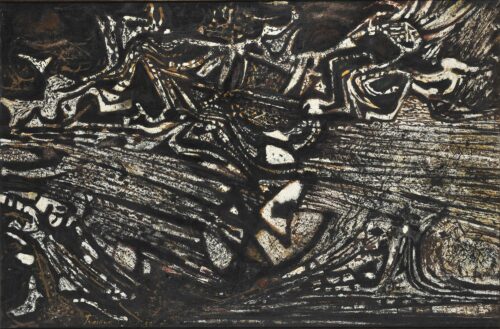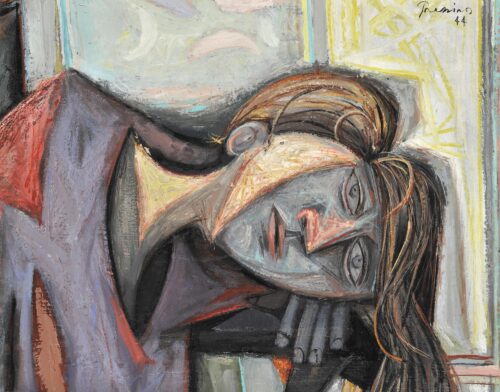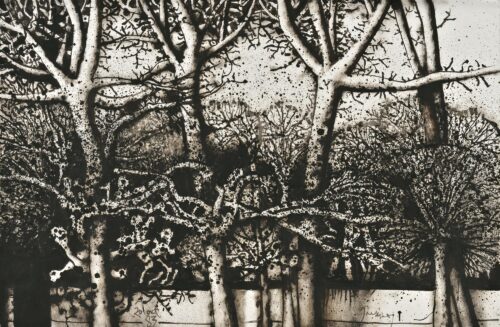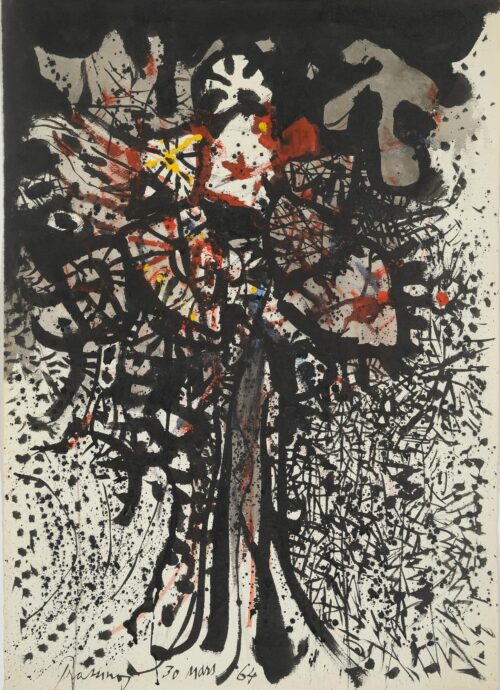
Prassinos Marios (1916 - 1985)
The Waves, 1959
Marios Prassinos was born in 1916 in Istanbul but grew up and studied in Paris, where he moved with his family after the expulsion of ethnic Greeks from Turkey in 1922. In 1932, he enrolled at the Ecole des Langues Orientales and had his first painting lessons with Clement Serveau. Two years later he began to study at the Faculte des Lettres in Paris. Both he and his sister, Gisele, who had just published articles in magazines such as “Documents 34” and “Minotaure”, were part of the broader circle of the surrealists. Characteristic of his work is his involvement with the theatre, his production of book illustrations and covers, his ongoing interest in transcending the threshold between knowledge and intuition, between the physical and the metaphysical world, and his approach to painting as writing. These are the main directions in his work, which also reflect the topics he investigated, from his earlier work, consisting of portraits and self-portraits already in a surrealistic direction, to the introversion of his renderings of the natural landscape, after he moved to Eygalieres, in the South of France.
He had his first solo exhibition in 1938 at the art gallery of Pierre Vorms, who had discovered the artist at the Salon des Surindependants. During the same year, he married Yolande Borelly. During the War began his collaboration with N.R.F. Editions (Gallimard). He met Albert Camus and Jean-Paul Sartre whose Le Mur he illustrated with colour prints. In cooperation with Raymond Queneau, in 1946 he published L’instant fatal, illustrated with his prints, and during the following year designed the costumes for Paul Claudel’s Tobie et Sara, produced by Jean Vilar at the Avignon Festival.
He worked with Vilar again in 1954, designing the sets and costumes for Macbeth. In 1951, he made his first tapestries and bought a house at Eygalieres where he lived until his death. He was a French citizen since 1949.
In 1953, he illustrated Edgar Allan Poe’s The Raven with woodcuts and etchings. In 1955 he had his first solo exhibition at the Galerie de France, followed by a number of exhibitions in the same venue. When, in the late 1950s, he traveled to Greece, he had already begun to study the genre of landscape.
In the 1960s and 1970s, he had exhibitions in France and other countries. He also continued to work for books (in 1973, Editions Gallimard published his book Les Pretextats) and for the theatre (in 1969, he designed the sets and costumes for Iannis Xenakis’s ballet “Eonta”). He was decorated as a Chevalier of Arts and Letters and a Chevalier of the Legion of Honour. In 1980, he exhibited at the Grand Palais his series “Paysages Turcs” (on which he had worked from the early 1970s) and “Shrouds”. In the following years, retrospective exhibitions of his work were held in France and Greece; one year after his death, in 1986, 11 large-scale paintings went on permanent display in the Notre Dame de Pitie chapel.

The Waves, 1959

Face, 1944

Trees, 1983

Composition, 1964

We use cookies to make our site work properly, to personalize content and ads, to provide social media features and to analyze our traffic. We also share information about how you use our site with our social media, advertising and analytics partners. Read the Cookies Policy.
These cookies are necessary for the website to function and cannot be switched off in our systems. They are usually only set in response to actions made by you which amount to a request for services, such as setting your privacy preferences, logging in or filling in forms. You can set your browser to block or alert you about these cookies, but some parts of the site will not then work. These cookies do not store any personally identifiable information.
If you disable this cookie, we will not be able to save your preferences. This means that every time you visit this website you will need to enable or disable cookies again.
These cookies tell us about how you use the site and they help us to make it better. For example these cookies count the number of visitors to our website and see how visitors move around when they are using it. This helps us to improve the way our site works, for example, by ensuring that users find what they are looking for easily. Our website uses Google Analytics for statistics reporting.
Please enable Strictly Necessary Cookies first so that we can save your preferences!